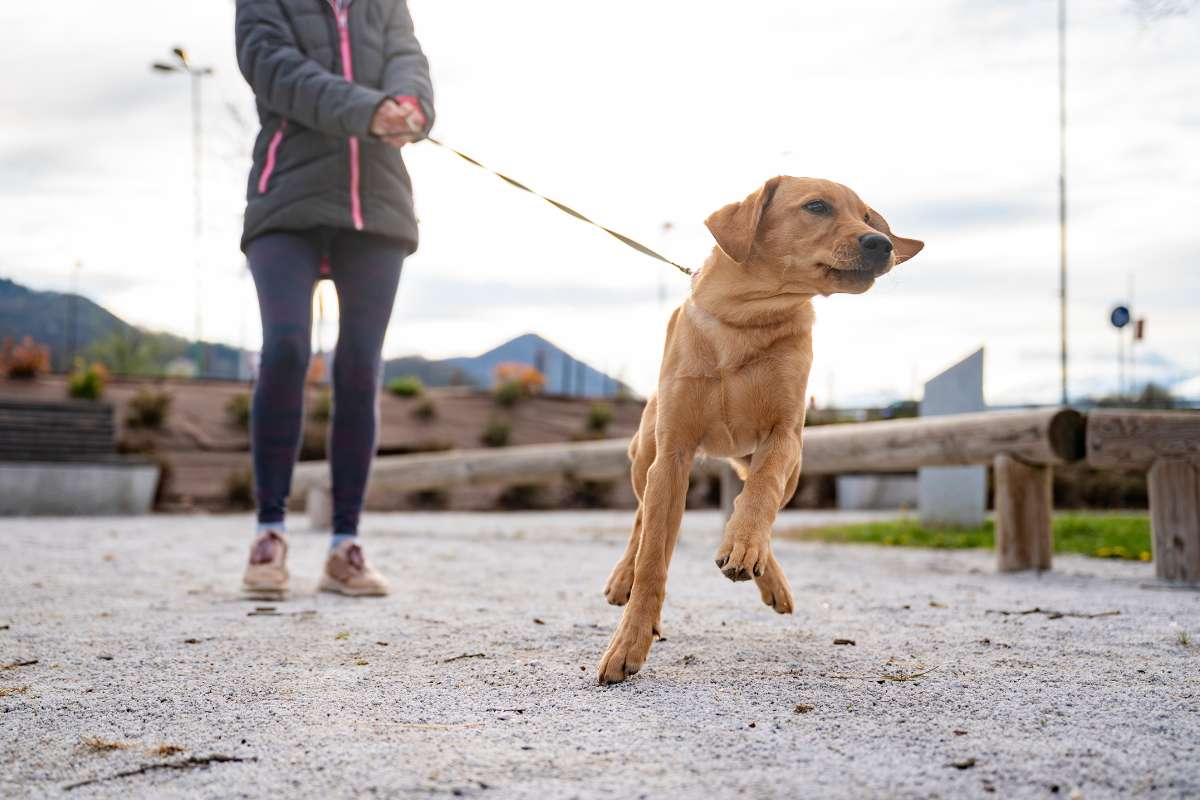Top 10 Reasons Why Your Dog Is Pulling on the Lead

What causes a dog to pull on the lead
There is no short or simple answer. Dogs pull on the lead for various reasons, each shedding light on their unique communication and needs. Excitement and the thrill of exploration can trigger pulling, showcasing their enthusiasm for the great outdoors. Lack of training contributes, as dogs may not have learned proper lead manners. Social instincts play a role, as they pull to engage with other dogs or people. Unmet exercise needs and distractions, like intriguing scents or prey drive, also lead to pulling behavior. Uncomfortable equipment, negative past experiences, and a lack of leadership can contribute. Understanding these factors allows pet owners to address pulling effectively.
Of course, walking your dog should be a joyful experience, a time to bond and explore together. Yet, if your canine companion transforms the leisurely stroll into a game of tug-of-war, frustration can replace enjoyment. Understanding why dogs pull on the lead is crucial to addressing this common issue effectively. In this comprehensive guide, we'll explore the top 10 reasons behind your dog's pulling behavior and provide insights on how to tackle each root cause.
1 - Excitement and Enthusiasm
Dogs are naturally energetic creatures, and the sheer thrill of going for a walk can result in enthusiastic pulling. Their excitement is a testament to their love for the outdoors and the anticipation of new scents, sights, and sounds.
Solution - Start by managing your dog's excitement before the walk. Practice calm behaviors at home, use a consistent command like "wait" before exiting the door, and reward your dog for staying calm. Gradually reinforce the desired behavior during walks, rewarding them for walking calmly by your side.
2 - Lack of Training
Dogs need to learn proper lead manners, and without consistent training, they may resort to pulling as a default behavior. If your pup hasn't received formal lead training or reinforcement of walking etiquette, pulling becomes their way of exploring the world.
Solution - Invest time in basic lead training. Use positive reinforcement techniques, rewarding your dog for walking beside you without pulling. Consistency is key – reinforce good behavior with treats, praise, or toys, and be patient as your dog learns.
3 - Desire for Exploration
Dogs are curious beings, and the enticing scents and sights outdoors can trigger a strong desire to explore. Pulling on the lead may signal their eagerness to investigate interesting smells, other animals, or intriguing spots.
Solution - Allow your dog some exploration time during walks. Incorporate stops for sniffing and investigating, making the walk an enriching experience. Use commands like "let's go" to encourage forward movement when needed, and reward compliance.
4 - Social Interaction
Dogs are social creatures, and encountering other dogs, people, or wildlife can elicit a pulling response. The desire to meet and interact with others may lead to an enthusiastic forward motion, especially if your dog lacks socialisation opportunities.
Solution - Prioritise socialisation to help your dog become more comfortable around others. Gradually expose them to different environments, people, and dogs. Reinforce calm behavior with treats or praise, gradually decreasing the excitement associated with social interactions.
5 - Lack of Exercise
Dogs with pent-up energy may resort to pulling as a means of burning off excess steam. Without adequate physical and mental stimulation, a walk becomes an outlet for their surplus energy, resulting in pulling behavior.
Solution - Ensure your dog receives sufficient exercise and mental stimulation before walks. Engage in playtime, fetch, or other activities to tire them out, making the walk more about leisure than an energy-burning mission.
6 - Uncomfortable Equipment
Ill-fitting or uncomfortable harnesses, collars, or leads can contribute to pulling behavior. Dogs may try to escape discomfort by moving away, leading to a constant forward motion.
Solution - Ensure your dog's gear is the right size and fits comfortably. Consider using a no-pull harness to discourage pulling and again use positive reinforcement when your dog walks well or by your side. Gradually introduce new equipment, allowing your dog to become accustomed to it positively.
7 - Prey Drive or Distractions
Dogs have an innate prey drive, and the sight of smaller animals, birds, or moving objects can trigger pulling behavior. Distractions in the environment, such as cars, bicycles, or other dogs, may also contribute to a heightened pulling response.
Solution - Train your dog to focus on you during walks, using treats or toys as rewards for maintaining attention. Practice commands like "leave it" or "watch me" to redirect their focus away from distractions and get the to look at you. Gradual exposure and positive reinforcement can help desensitise your dog to triggers.
8 - Unmet Social or Emotional Needs
Dogs may pull on the lead as a way of expressing unmet social or emotional needs. Loneliness, anxiety, or a lack of companionship can manifest as excessive pulling during walks, seeking solace or connection with the outside world.
Solution - Address your dog's emotional needs by providing companionship, mental stimulation, and a nurturing environment. Consider interactive toys, puzzle feeders, or even enrolling in doggy daycare to alleviate loneliness.
9 - Negative Experiences
If your dog has had negative encounters or experiences during walks, they may develop a pulling behavior as a protective mechanism. Fear or anxiety can trigger a desire to escape from perceived threats.
Solution - Gradually expose your dog to positive experiences during walks. Use treats, praise, and gentle encouragement to create positive associations with the outdoors. If your dog has experienced trauma, consult with a professional dog trainer or behaviorist for specialised guidance.
10 - Lack of Leadership
Dogs thrive on structure and clear leadership. Without a confident leader, they may assume the role themselves, leading to pulling as a way of taking charge of the walk.
Solution - Establish yourself as the pack leader through consistent training, clear communication, and positive reinforcement. Use commands like "heel" or "close" to reinforce walking by your side. Show confidence and calmness during walks to assure your dog that you are in control.
Conclusion - Understanding the root causes behind your dog's pulling behavior is the first step toward fostering a positive walking experience. Whether it's excitement, lack of training, or unmet needs, addressing the underlying issues with patience, consistency, and positive reinforcement can transform your walks into enjoyable adventures for both you and your furry companion. By identifying and working on these reasons, you'll build a stronger bond and create a harmonious walking routine that benefits both you and your canine friend.
Wiggles and Wags offers a range of dog walking aids on this website. Why not explore the options.
-
Posted in
walking behaviour





